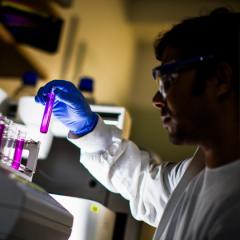Researchers at The University of Queensland in Australia and Albert Einstein College of Medicine in the US have developed a new statistical method for discovering elusive cancer-promoting genes.
The team, led by Associate Professor Jess Mar of the University of Queensland’s Australian Institute for Bioengineering and Nanotechnology, used the method to identify a gene that appears to promote the growth of aggressive breast cancers.
The new approach could be used to reveal many previously hard-to-find genes that contribute to cancer.
The majority of cancer-promoting genes, known as ‘oncogenes’, identified to date were found because they show up in most patients with a particular cancer type.
When you average the data across those patients, those common oncogenes tend to stand out, but they don’t paint the full picture.
“We’re still missing a lot of information,” said A/Prof Mar.
“Even if a group of people all have the same type or even subtype of cancer, the molecular makeup of that cancer is different from person to person because the activity of genes vary between people,” she said.
“So it is possible that there are many other undiscovered oncogenes out there that happen to act differently from person to person.”
“If an oncogene is over-active in one group of patients but inactive in another group, that’s statistically harder to see using the tools that we have available,” she explained.
“If you only look at the average activity of a gene across the two groups, you’d never see the high activity in the first group.”
To find such genes with two different behaviours, A/Prof Mar and her colleagues designed a statistical method, called Oncomix, that enables them to zoom in on genetic data from cancer patients and identify genes with two distinct ‘bumps’ of data: low activity in one group of patients but high activity in another.
“This method is striking the sweet spot between assuming that everyone is identical (which biology tells us that they’re not) and identifying patterns specific to one person (which is hard to do using statistics),” said A/Prof Mar. “We’re acknowledging that there is diversity amongst cancer patients, but we’re still looking for trends in the data that pertain to groups of people.”
She and her colleagues then used Oncomix to examine breast cancer data from a large patient database called The Cancer Genome Atlas.
They identified five genes that were over-active in a subset of breast cancer patients and followed up on the most promising one, a gene called CBX2.
Previous studies have shown that most healthy female tissue has low levels of CBX2 activity, while an aggressive subtype of breast cancer has been shown to have high levels of CBX2 activity. This suggested a possible link between CBX2 activity and breast cancer, but the nature of that link was unclear.
“No one has perturbed this gene in breast cancer before to see what effect it had on the cancer,” said A/Prof Mar.
“So we switched it off in a human breast cancer cell line and this slowed down the growth of those cancer cells.”
“This finding suggests CBX2 might promote tumour growth,” she said.
More tests are needed to confirm whether CBX2 is indeed a true oncogene, but if it is, then it could be a potential therapeutic drug target for aggressive types of breast cancer.
Moreover, the discovery highlights the potential value of the Oncomix approach, said A/Prof Mar.
“Identifying ‘missing’ oncogenes that are unique to smaller groups of cancer patients will open up new therapeutic avenues and move us closer to personalised medicine,” she said.
Oncomix is now a publicly-available, open source software tool, and the study has been published in the British Journal of Cancer.


